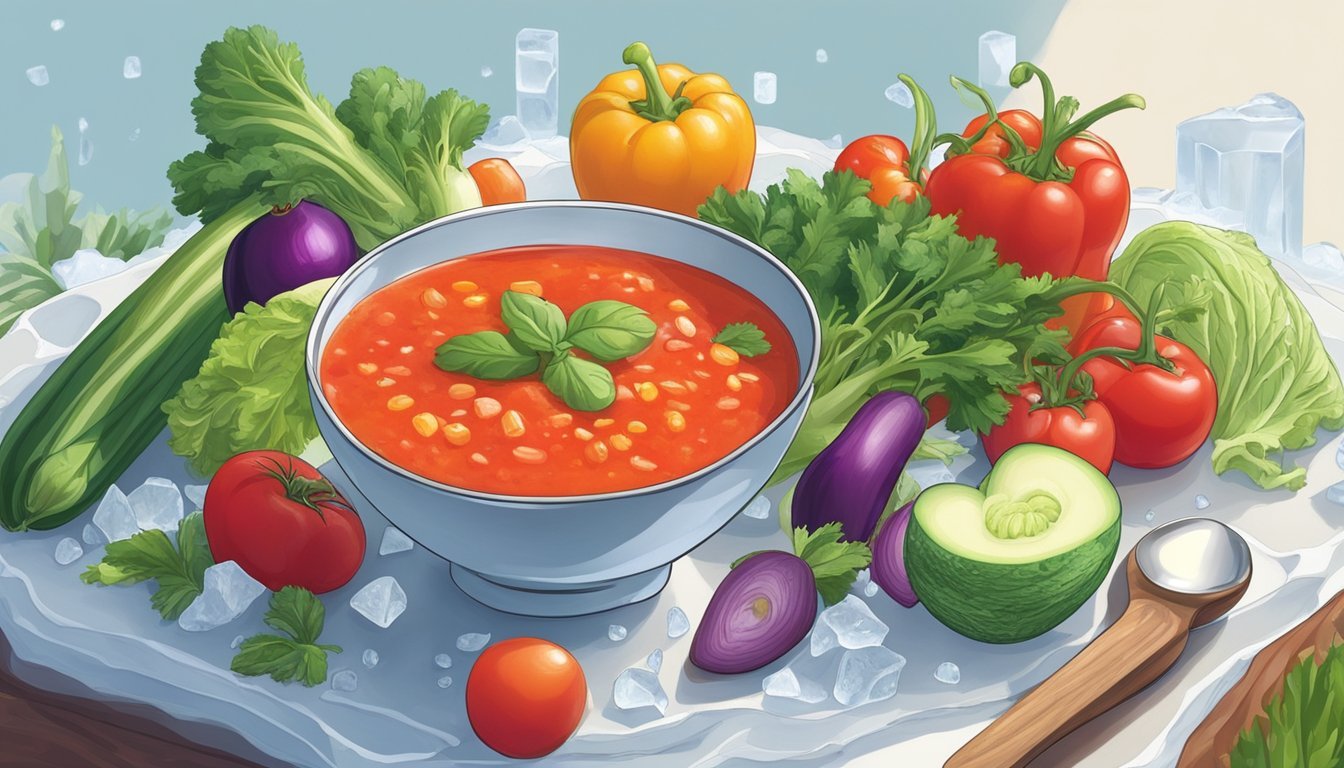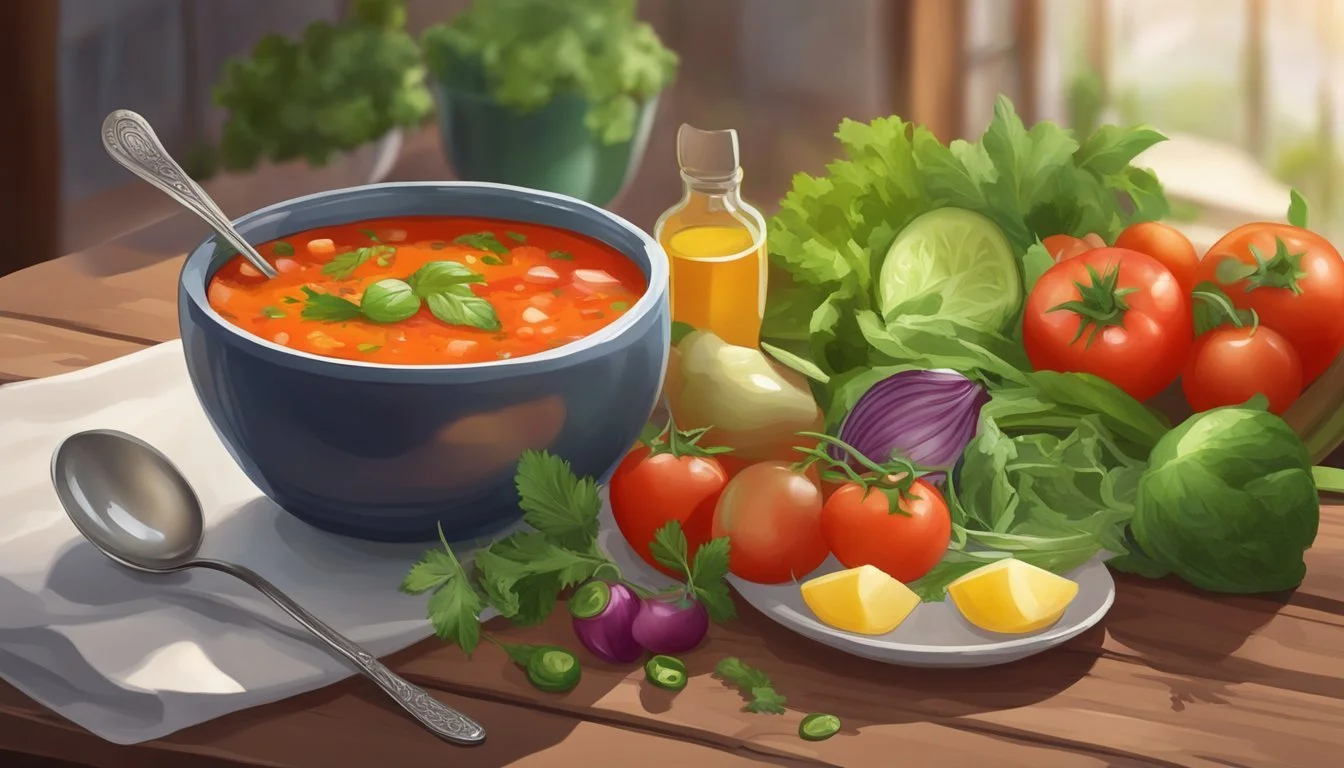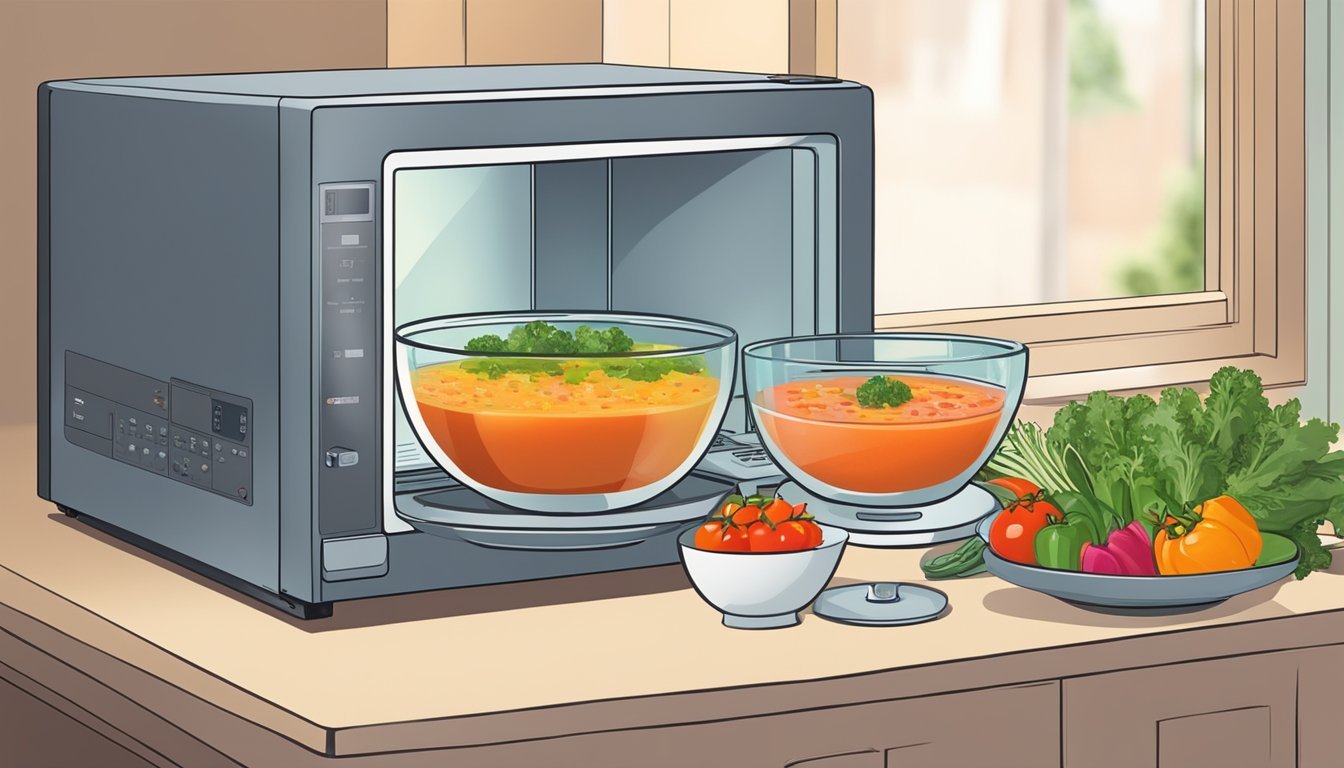Best Way to Reheat Gazpacho
Ensuring Optimal Chill and Flavor Retention
Gazpacho is a traditional Spanish soup known for its refreshing qualities, served cold, making it a popular dish during the warmer seasons. Reheating gazpacho may seem counterintuitive; however, the process is not about warming the soup but rather about reviving its chilled temperature and vibrant flavors after storing. Proper technique ensures that gazpacho retains its unique texture and taste that can be dulled when improperly handled after refrigeration or freezing.
Maintaining the chill and bright profile of gazpacho requires attention to detail, particularly when it has been stored in the refrigerator or freezer. It is essential to understand the components of gazpacho such as the balance of acidity, the texture of the vegetables, and the integration of olive oil. Methods of restoring the soup's temperature and flavor without compromising its integrity are crucial for an optimal tasting experience.
As gazpacho sits, ingredients may settle or separate, and the cold temperature necessary for its refreshing taste may diminish. Restoration is simple and should always aim to achieve a homogenous blend with vibrant flavors and a cool temperature akin to its initial preparation. Through careful handling and knowledge of gazpacho's characteristics, one can easily ensure that the dish is revitalized and served as intended, brimming with fresh taste and maintaining its brisk, delightful chill.
Understanding Gazpacho
Gazpacho is a cold soup known for its refreshing qualities and rich history, primarily originating in Andalusia, Spain. This section delves into the roots and characteristics of gazpacho, along with its traditional ingredients and the flavors they create.
History and Origin
Gazpacho is believed to have originated in the southern region of Andalusia in Spain. Its history can be traced back to the times when the Roman Empire ruled the area, introducing a simple concoction of bread, olive oil, and water. Later, with the discovery of the New World, tomatoes (What wine goes well with tomatoes?) and peppers were incorporated, which greatly influenced the gazpacho we know today. Typically enjoyed in hot summer months, gazpacho offers a cooling relief from the scorching Spanish sun.
Defining Characteristics of Gazpacho
Gazpacho is distinguished by its preparation and consumption methods. Unlike typical soups (What wine goes well with soups?) that are served hot, gazpacho is served chilled and is not cooked, preserving the bright and fresh flavors of its ingredients. It's a blend, resulting in a smooth or slightly chunky texture. Gazpacho is also known to be versatile, with variations influenced by regional preferences and seasonal ingredients.
Common Ingredients and Flavor Profile
The classic gazpacho recipe includes a base of ripe tomatoes, offering a sweet and tangy profile that is foundational to the dish. Other common ingredients include:
Cucumber: Provides a crisp and refreshing quality.
Pepper: Usually bell peppers (What wine goes well with bell peppers?), they contribute a mild sweet or earthy note.
Onion and Garlic: Add depth and a slight sharpness.
Olive Oil: Brings smoothness and enriches the flavor.
Vinegar: Typically sherry or red wine vinegar, adds a bright acidity.
Salt: For seasoning and enhancing other flavors.
These ingredients are carefully blended together to create a harmonious flavor that is savory, tangy, and refreshing. The result is a mélange that captures the essence of a radiant summer in Spain.
Preparation Techniques
Achieving the optimal taste and consistency of gazpacho starts with meticulous preparation. Choosing quality ingredients and employing the correct blending technique are crucial steps in crafting a delightful chilled soup.
Selecting the Right Ingredients
Freshness is paramount when selecting ingredients for gazpacho. Chefs should use ripe tomatoes, crisp cucumber, and firm bell peppers as the vegetable base. It is vital to incorporate garlic for aromatic depth, while high-quality extra-virgin olive oil lends a velvety texture and enhances the soup's flavors. An appropriate balance of vinegar and salt is essential to brighten and elevate the gazpacho's taste profile.
Blending for the Perfect Texture
The blending process dictates the gazpacho's final texture, which can range from smooth to chunky based on preference. Using a blender or food processor, chefs should blend the vegetables to their desired consistency. For a smooth gazpacho, they must blend until the mixture is completely pureed. For a more chunky texture, a shorter blend time will leave desirable bits of vegetables for added body.
Chilling Methods
To maintain the chilled essence and vibrant flavors of gazpacho, careful consideration of the chilling method is crucial. Both refrigerating and freezing play roles in preserving gazpacho, albeit with distinct purposes and techniques.
Optimal Refrigeration
When refrigerating gazpacho, using a sealed container is essential to avoid the absorption of other flavors from the refrigerator. The soup should be chilled for at least 2 hours, allowing it to reach a uniformly cold temperature throughout. For the flavors to fully integrate, an extended chilling period of up to 24 hours can be beneficial. Starting with chilled ingredients, such as the crusty bread often included for texture, further minimizes additional refrigeration time and keeps the soup refreshingly cold.
Freezing Considerations
While freezing is not a traditional method for storing gazpacho due to potential changes in texture, it can be utilized for longer storage. If freezing gazpacho is necessary, one should do so in small quantities, using an immersion blender to re-emulsify the soup after thawing for a smoother consistency. To prevent ice crystal formation, which can dilute flavor and alter texture, gazpacho should be stored in an airtight container, leaving some space to allow for expansion as it freezes. Gazpacho should be consumed within a few months of freezing to enjoy its best quality.
Reheating Without Heat
In the context of gazpacho, 'reheating' is essentially a process to return the cold soup to its optimal chilled temperature for consumption. This method ensures that the flavors stay vibrant and the soup remains refreshing.
Keeping Gazpacho Cold
Gazpacho should be served chilled to maintain its bright flavors and refreshing quality. When one needs to "reheat" or rather bring gazpacho back to its ideal cold temperature after it has been sitting out, the key is to do it in a way that prevents the soup from warming up too much in the first place.
Storing Leftovers: Immediately store any leftover gazpacho in the refrigerator. It's best to keep the soup in a sealed container to maintain its freshness and prevent the absorption of other flavors from the refrigerator.
Serving:
Bowl: Transfer the chilled soup into a cold serving bowl. To enhance the cooling effect, one can chill the bowl beforehand by placing it in the refrigerator or freezer.
Glass: Similarly, if serving in a glass for an elegant presentation, ensure the glass is pre-chilled to keep the gazpacho cold longer.
By keeping gazpacho properly chilled, it can retain its vibrant taste and refreshing quality, making it an ideal dish for hot days or as a bright starter to a meal.
Enhancing Gazpacho Flavors
Properly balancing acidity and incorporating herbs and seasonings are critical for enhancing the flavors of gazpacho. Achieving a bright and refreshing taste relies on the careful selection and combination of these components.
The Role of Acidity
Acidity in gazpacho is vital for highlighting its refreshing taste. It can be adjusted using various vinegars or citrus juices depending on the desired outcome:
Vinegar Choices:
Sherry Vinegar: Traditional in Spanish cuisine, sherry vinegar adds a smooth, nuanced tartness.
Red Wine Vinegar: Offers a robust tang that complements tomato-based gazpachos.
Balsamic Vinegar: Delivers a sweet and complex acidity ideal for balancing savory flavors.
To achieve the best flavor, one should start by adding a small amount of vinegar — usually a teaspoon per serving — and adjust according to taste. A well-balanced gazpacho should have a bright zing without overpowering the palate.
Herbs and Seasonings for Brightness
Herbs and seasonings enhance gazpacho by introducing refreshing and complex flavors:
Fresh Herbs:
Cilantro: Adds a lively, citrusy note that pairs well with vegetables.
Other herbs such as basil or parsley can be used to give a different dimension to the gazpacho.
Seasonings:
Salt and Pepper: Essential in bringing out and harmonizing the flavors within the gazpacho. A pinch of salt is often all it takes.
Cumin: Introduces a warm, earthy character without overpowering the dish.
Garlic:
Fresh Garlic: Lends a sharp, pungent flavor that mellows once chilled.
Each ingredient added should serve to accentuate the natural flavors of the primary components. It's important that the gazpacho is tasted and seasoned as one goes along to ensure that no single flavor dominates.
Serving and Presentation
Gazpacho is traditionally served cold, and its vibrant flavors are best preserved when maintaining this temperature. The presentation of this classic Spanish soup can significantly influence its enjoyment, so it is imperative to consider both its role in the meal and the choice of garnishes.
Gazpacho as an Appetizer or Main
When serving gazpacho, one should decide whether it will feature as an appetizer or the main course. If presented as an appetizer, it is commonly portioned into smaller bowls or elegant glasses to whet the appetite without filling diners up before the main course. As a main dish for lunch, larger bowls are used to deliver a satisfying portion, with the soup often being the star of a light and refreshing meal.
Garnishes and Toppings
To enhance the experience of enjoying gazpacho, consider adding a variety of toppings and garnishes that complement the soup's flavor profile:
Croutons: Add a crunchy texture.
Avocado: Introduce creaminess.
Herbs: Fresh herbs like parsley or cilantro can add a burst of color and freshness.
Olive oil: A drizzle of high-quality extra virgin olive oil can bring out the depth of the soup's flavors.
Here is a simple guide to suggested toppings, which can be added directly to the serving bowl for visual appeal and a burst of flavor:
Garnish Purpose Serving Suggestion Croutons Texture Sprinkle on top Avocado Creaminess Cube and distribute evenly Herbs Freshness and color Finely chop and garnish Olive Oil Flavor enhancement Drizzle before serving
One may choose a single garnish or a combination to create a more complex and engaging dish.
Gazpacho Variations
Exploring the realm of gazpacho variations reveals the rich tapestry of regional adaptations and innovative recipes that transform this traditional chilled soup into a vibrant array of flavors and textures.
Regional Differences
Andalusia is often credited as the birthplace of the classic gazpacho. In this southern Spanish region, the soup embodies a perfect balance of ripe tomatoes, cucumber, green bell peppers, and garlic, all pureed to create a refreshing cold dish often served in the hot summer months. However, neighboring areas and countries like Portugal put their own twist on gazpacho, adding local ingredients and flavors that represent their culinary culture.
Across the Iberian Peninsula, one can find green gazpacho, known for its inclusion of green vegetables like cherry tomatoes and green bell peppers, alongside an English cucumber. This version stands out for its vivid color and slightly milder taste compared to the bold red of the traditional version.
Alternative Gazpacho Recipes
Innovation in gazpacho recipes has led to the creation of fruit-based versions of the soup, which mark a departure from the classic tomato-centric base.
Melon Gazpacho: This recipe utilizes the sweetness of ripe melon to produce a cooler that is both sweet and savory.
Watermelon Gazpacho: This variation marries the refreshing taste of watermelon with the acidity of tomatoes to create a unique summertime soup.
These fruit-infused gazpachos may also include ingredients like cherry tomatoes and red bell pepper to balance the sweetness with traditional gazpacho savoriness. Each recipe offers a harmonious blend of flavors while maintaining the integrity of the chilled dish's essence.
The gazpacho continues to be a canvas for culinary expression, with each region and chef adding their signature while honoring the cold soup's storied history.
Storage and Leftover Tips
For gazpacho enthusiasts looking to savor their soup, proper storage techniques are essential to maintain freshness and flavor. Leftover gazpacho requires careful handling to ensure it remains an enjoyable dish.
Short-term Storage
Refrigeration is key for short-term storage of leftover gazpacho. It should be stored in a sealed container as soon as it has cooled down to room temperature.
Timeframe: Ideally, consume within 1-2 days to enjoy its bright flavors. Some sources suggest up to 4-5 days can be acceptable for freshness.
Tips:
Prioritize airtight containers to minimize exposure to air.
Keep it at a consistent, cold temperature, avoiding the fridge door where temperatures can fluctuate.
Long-term Storage Solutions
For individuals unable to consume their leftover gazpacho in a short time frame, freezing is a feasible option.
Method:
Pour the gazpacho into freezer-safe bags or containers.
Leave some space at the top as liquids expand when frozen.
Thawing: To thaw, transfer the container to the refrigerator and allow it to defrost slowly. It's best consumed soon after thawing for maximum taste.
Duration: Frozen gazpacho can last for several months but is optimal if enjoyed within 2 months.
Nutritional Information
Gazpacho, a chilled soup often celebrated for its vibrant flavors, is also recognized for its nutritional benefits. This section will detail the health advantages and dietary considerations of gazpacho.
Health Benefits of Gazpacho
Gazpacho is a rich source of vitamins and minerals, primarily because it is typically made with a variety of fresh vegetables including tomatoes, bell peppers, onions, and cucumbers. These vegetables contribute to the soup's high content of vitamin C, potassium, and other essential nutrients beneficial for maintaining good health. The inclusion of tomatoes is particularly noteworthy as they offer lycopene, an antioxidant linked to reducing the risk of heart disease.
The soup often contains olive oil, especially extra-virgin olive oil, which provides monounsaturated fats. These healthy fats are associated with positive cardiovascular effects. Furthermore, extra-virgin olive oil is known for its anti-inflammatory properties.
Dietary Considerations
Gazpacho can be an excellent option for individuals following various diets:
Vegan and Paleo: It usually lacks any animal products, aligning it with vegan principles, and its focus on whole, unprocessed vegetables suits the paleo dietary framework.
Nut-Free: Given that gazpacho typically doesn't include nuts, it's safe for those with nut allergies.
Low Calorie: Vegetables used in gazpacho are low in calories, making this dish a suitable choice for weight management diets.
It's imperative for consumers to ensure that no additional ingredients outside of their dietary restrictions are added to the recipe. As with any dish, specific dietary needs and restrictions should guide the selection of a gazpacho recipe to follow.











